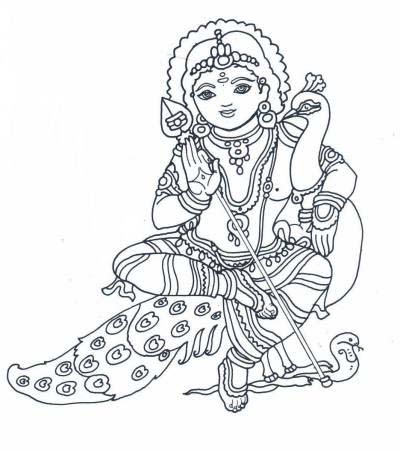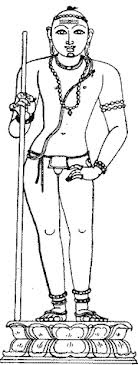
‘Muruga’; the very word spells charm, splendour, beauty, knowledge and power. The people worship Him, admire Him, adore Him, respect him and love Him because they find that there is a divine and magnetic appeal in Him. Muruga, the Lord of love and compassion exercises an enormous influence on the people. In Palani, we find a human ocean with the strong under current of devotion running through them. What prompts them all towards Muruga? Why is Muruga so special? What is unique about Muruga? The faith is so strong that devotees believe that Muruga comes into their life and graces them as God, helps them as a friend, guides them as Guru and guards them as a savior. How they got this conviction? What is the moving force behind it? It can never be explained but only experienced by one whose heart is filled with devotion.
However, Kanda Puranam which describes the origin, purpose and the life history of Muruga indicates how Muruga has come to be regarded as the Supreme Power. Kanda Purna describes Muruga as a unique and extra-ordinary power. He was not naturally born. He was formed from the powerful flame of fire that originated from the third eye of Lord Siva, the eternal reality. Though originated from Siva, he excelled in the knowledge and power of Siva. He even acted as the Guru to Siva and gave him the enlightened advice. Such an unparalleled power called Muruga was created in order to destroy the demon, Soorapadaman who had got a boon of immortality and in order to protect the devotees from the world of illusion.
Thus Muruga has come to possess a power that is unequalled. He is known as the epitome of knowledge. He is known as all powerful. He is known as the embodiment of beauty. He is known as the ultimate God or as God of all Gods. He is described as an extension of Siva, the eternal reality, the one without a second. He is special because he has the unique combination of the power of Sakthi derived from Mother Parvati and the power of knowledge acquired from father Siva. He appeared on earth with the combination of all powers and knowledge with a view to provide peace and security.
Having nursed by Karthigai maidens who shine as brilliant stars in the galaxy and having brought up by Siva and Parvati with care and affection, Muruga grew up as a handsome youth (Kumara). With the powerful Vel (lance) presented by Parvati, Muruga came to Tiruchendur and put an end to the atrocities of Soorapadman and other distractors and restored peace and tranquility on earth.
It is impossible to visualize the image of Muruga without Vel (lance). The Vel represents not only the power to destroy but also the power to protect. It is believed that the power of Vel excels all the three divine weapons held by Siva (trishul), Vishnu (discus) Indira (vajrayudha). The lance radiates the light of knowledge and is known as Kadir Vel. The Vel of Muruga is powerful enough to bring light of knowledge where there is ignorance. Though many pundits described Muruga and Vel in glorious terms, it was Arunagirinathar who described Muruga very beautifully, truthfully and completely. Arunagirinathar described Vel as the weapon that destroyed the Krownja mountain, symbolizing the ego of Soorapadman. In his Vel Vakuppu, Arunagirinathar says that the Vel carries the power to ward off the adverse effects of Karma (consequences arising out of our action). It has the power to remove the fear of death. It brings confidence, courage, happiness, health and prosperity. It guides the way to the Lotus Feet of Muruga. Thaipusam is celebrated in a grand manner at Palani. The word Thaipusam comes from the Tamil month of Thai and the star Pusam). It was on this day, mother Parvati gave Muruga the powerful Vel which destroyed the demon, Sooran.
Muruga defies description. He is known as ‘Su Brahmanya’, ‘Su’ signifying sacred and ‘Brahmanya’ signifying the eternal reality, Brahman. He is known by the knowledge he symbolizes; Jnana Pandita, by his qualities of love and compassion; Karunakara. Since he was carried by Ganga, he is known as Kangeyan and since he was nursed by stars from the galaxy, he is known as Karthikeya. Since he manifested to remove the miseries and sorrows of the age of Kali, he came to be known as Kaliyuga Varada. He is known by the six sacred letters he symbolizes; Saravanabhava, by the spear he wields; Velayudha, by the peacock he travels; Mayilvahana, by his ensign of rooster; Seval Kodiyon, by the garland he wears; Kadamba, by the staff he holds at Palani, Dhandayuthapani, by the place he resides like Vayaloora and by his six sacred faces, Shanmugha. He is known as Thambiran, the leader, as Andi, the renounced saint and as Swaminatha, the enlightened Guru. He is also known as Guhan. The word ‘guha’ means cave. Since Muruga resides in the cave of the heart of devotees, he has come to be known as Guhan. He appears as a youth (kaumara) in Tiru Avinangudi, as a conqueror in Tiruchendur, as a Samsarin (in family) in Tiruthani and Tiruparamkundram, as a renounced saint in Palani and as a matured old man in Pazhamudir Solai. It is believed that Muruga is the integrated form of Lord of Fire, (agni), Indira, Varuna, Brahaspati, Hiranya Garbam. Adarvana Veda describes him as the son of Agni. In Bhagawad Gita, Lord Krishna says: “Among the warriors, I am Skanda”.
Generally, there is a misconception that by going to Palani, one may gain something, but the fact is he will lose many things; his anger, his ego, his attachment, his aversion and above all ‘he’ himself. The concept of ‘I’ goes and he becomes ‘that’. .
Please visit the following Websites
Tiruchendur Murgan
Kaumaram
Thai Pusam



